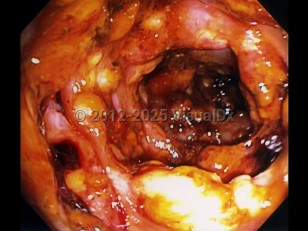Clostridioides difficile colitis
Alerts and Notices
Important News & Links
Synopsis

CDI occurs mostly in elderly and severely ill patients who are hospitalized or reside in long-term care facilities where environmental exposure to C difficile spores is common. The overall number of health care-associated C difficile infections in the United States is decreasing; there may be multiple factors involved. Infection in children is less common, but pediatric cases have risen since 2000 in both community and health care settings. Neonates are known to be colonized with C difficile but are asymptomatic, possibly because of the lack of specific binding sites in their gastrointestinal tract.
Most of the infections occur after use of antibiotics, which disrupt the normal intestinal flora. Any antibiotic, even when used for a short duration such as for surgical prophylaxis, can lead to CDI. Some studies have linked infection more commonly with the use of third- and fourth-generation cephalosporins, fluoroquinolones, carbapenems, and clindamycin. CDI has also been associated with cytotoxic chemotherapy, use of proton pump inhibitors, and histamine receptor antagonists, although some of the data are conflicting.
Other risk factors for CDI include enteric feeding, gastrointestinal surgery, inflammatory bowel disease, chronic kidney disease, end-stage renal disease, prolonged hospitalization, and immunocompromised states such as HIV infection or solid organ or stem cell transplantation. Patients who are able to mount an antibody response to toxin A after acquisition of C difficile are less likely to develop symptomatic disease and to have recurrent disease.
The epidemiology of CDI has expanded to include young and healthy persons with no contact with the health care environment. Some of these healthy individuals had not received antibiotics, and in some, transmission occurred between close contacts. Severe disease requiring colectomy has also been reported in peripartum women. It is therefore important to include C difficile in the differential diagnosis of diarrhea in the outpatient setting, especially if the diarrhea lasts more than 3 days and is associated with blood in the stool or fever.
The incubation period for CDI is not well established but may occur within 2-7 days after colonization. Most symptomatic patients have received antibiotics within the previous 14 days.
Symptoms of CDI range from mild diarrhea to fulminant pseudomembranous colitis, toxic megacolon, perforation, and death.
Recurrence of CDI occurs in 10%-30% of cases, with the risk of recurrence increasing with each successive recurrence. While overall cases of CDI have plateaued, rates of recurrent CDI have more than doubled since the early 2000s. The recurrence can be similar to the initial infection or can be more severe. Patients on proton pump inhibitors are at increased risk for recurrence.
Codes
A04.71 – Enterocolitis due to Clostridium difficile, recurrent
A04.72 – Enterocolitis due to Clostridium difficile, not specified as recurrent
SNOMEDCT:
423590009 – Clostridium difficile colitis
Look For
Subscription Required
Diagnostic Pearls
Subscription Required
Differential Diagnosis & Pitfalls

Subscription Required
Best Tests
Subscription Required
Management Pearls
Subscription Required
Therapy
Subscription Required
Drug Reaction Data
Subscription Required
References
Subscription Required
Last Updated:03/03/2024

